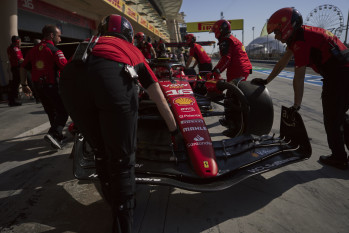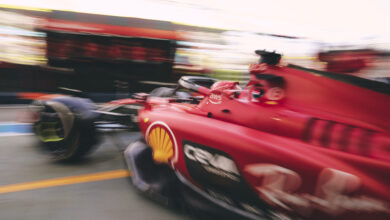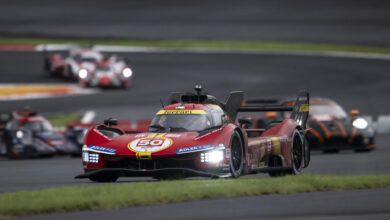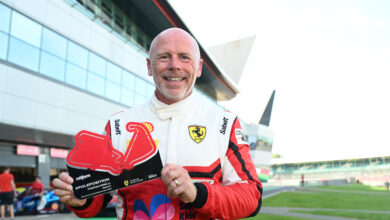Australian Grand Prix – The longest trip
Maranello, 29 March 2023 – As was the case last year, Melbourne’s Albert Park circuit hosts the third round of the Formula 1 World Championship.

Timetable
Friday, March 31
FP1: 12.30 local time – 3.30 CET
FP2: 16 local time – 7 CET
Saturday, April 1
FP3: 12.30 local time – 3.30 CET
Qualifying: 16 local time – 7 CET
Sunday, April 2
Race: 15 local time – 7 CET
Three questions to…
ANDREA FERRARI, PERFORMANCE COACH CHARLES LECLERC
1. This is the longest trip of the season: how do you minimise the effect of such a long journey and what can the drivers do to overcome jetlag?
“Managing jetlag is one of the trickiest problems for a driver. The Formula 1 calendar takes in four continents and so there are a lot of time changes to deal with. A lack of sleep, which means getting less than five hours, as well as the quality and amount of sleep can have a significant effect on an athlete’s performance. It can influence learning, memory, pain perception, inflammation of certain parts of the body and the immune system. The Australian time difference is one of the hardest to deal with, Melbourne being ten hours ahead of Italy. The most important thing is to look at the flight timings and then decide when it is best for the driver to sleep on the flight and when to stay awake to minimise the jetlag after landing”.
2. Are there any special needs as regards nutrition on a flight, a diet to follow on the flight and what to eat after arrival?
“When it comes to nutrition and hydration everything is planned around the flight. We carefully study when are the best times to eat during the flight, which often do not align with when the airlines offer meals on-board and of course we also pay great attention to what type of food is best. Meals can also impact sleep, therefore light and only slightly seasoned meals are best”.
3. And what about yourself? What is your role? What is the best part about it and what is the most demanding aspect?
“I am in overall charge of Charles’ physical performance and, in addition to planning his fitness training, I coordinate physiotherapists, nutritionists, biologists, physiologists and specialist doctors, who are also involved in ensuring his performance level and general wellbeing. With a busy race calendar, a demanding part of this role is making sure that all parties are perfectly aligned and in condition to make decisions based on the latest developments. I really enjoy my work and feel I make a significant contribution to building his performance. It’s what I studied for and I constantly strive to expand my knowledge, dedicating a large part of the year to this”.
Andrea Ferrari
Nationality: Italian
Born on 25/5/1979
In: Viareggio (Tuscany)
Photos of Andrea Ferrari are available for download at
https://we.tl/t-QFFsYdohKB
Ferrari Stats
GP contested 1054
Seasons in F1 74
Debut Monaco 1950 (A. Ascari 2nd; R. Sommer 4th; L. Villoresi ret.)
Wins 242 (22,96%)
Pole positions 242 (22,96%)
Fastest laps 259 (24.57%)
Total podiums 798 (25.24%)
Ferrari Stats Australian Grand Prix
GP contested 36
Debut 1985 (S. Johansson 5th; M. Alboreto ret.)
Wins 10 (27,78%)
Pole positions 7 (19,44%)
Fastest laps 10 (27,78%)
Total podiums 26 (24,07%)
Australian Grand Prix: facts & figures
4. The number of Australian Grands Prix run at Melbourne in which there was only one race leader. The most recent time this happened was last year and Charles was the driver in question, on the way to his first “grand chelem,” with the win, pole position and fastest race lap, leading from lights out to chequered flag. Other drivers to have led from start to finish are Nico Rosberg (2014) Jenson Button (2009) and Michael Schumacher (2004). As for races run in Adelaide, Ayrton Senna led all the way in 1991, albeit in a race stopped after 14 laps because of torrential rain and Gerhard Berger in 1987 in the Ferrari F1-87.
6. The number of foxes to be found per square kilometre in Melbourne, more than in any other city in the world, according to figures published by the state of Victoria in 2020. Nevertheless, you don’t see them very often as they are extremely shy, careful and nocturnal.
46,4. The highest temperature, in degrees Celsius ever recorded in Melbourne. It happened during a heatwave around the end of January and beginning of February 2009. The highest temperature ever recorded in the state of Victoria was 48.8° in Hopetoun. Australia is well known for the dangerous and famous hole in the ozone layer, which actually closed up in 2021.
1835. The year the city of Melbourne was founded. The settlement was originally known as Batmania, not because the early settlers were keen followers of the masked crusader from Gotham City, who first saw the light of day in 1939. The name honoured John Batman, the explorer who established the town on the banks of the Yarra river, in the sacred aboriginal land of Wurundjeri, realising it was a good site on which to build a city. In 1837, the city was named after the then British Prime Minister, Lord William Lamb, Viscount Melbourne.
1970. The year in which the wearing of car front seat belts became compulsory in the State of Victoria. They were invented in the mid-19th century by English aviator George Cayley. The first patent for their use in the automobile industry was given in 1885 to New Yorker, Edward J. Claghorn. The first car to be designed with seat belts as standard was the 1948 Tucker Torpedo. Immediately after the State of Victoria, also in 1970, Czechoslovakia also made their use compulsory. Two years later, the Sabelt company was established in Italy by Piero and Giorgio Marsiaj and today it is a Technical Partner of the team, supplying Scuderia Ferrari’s seat harnesses for Formula 1.




